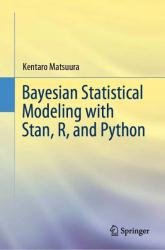Bayesian Statistical Modeling With Stan, R, and Python
- Добавил: literator
- Дата: 25-01-2023, 16:36
- Комментариев: 0
 Название: Bayesian Statistical Modeling With Stan, R, and Python
Название: Bayesian Statistical Modeling With Stan, R, and PythonАвтор: Kentaro Matsuura
Издательство: Springer
Год: 2023
Страниц: 395
Язык: английский
Формат: pdf (true), epub
Размер: 41.5 MB
This book provides a highly practical introduction to Bayesian statistical modeling with Stan, which has become the most popular probabilistic programming language.
The book is divided into four parts. The first part reviews the theoretical background of modeling and Bayesian inference and presents a modeling workflow that makes modeling more engineering than art. The second part discusses the use of Stan, CmdStanR, and CmdStanPy from the very beginning to basic regression analyses. The third part then introduces a number of probability distributions, nonlinear models, and hierarchical (multilevel) models, which are essential to mastering statistical modeling. It also describes a wide range of frequently used modeling techniques, such as censoring, outliers, missing data, speed-up, and parameter constraints, and discusses how to lead convergence of MCMC. Lastly, the fourth part examines advanced topics for real-world dаta: longitudinal data analysis, state space models, spatial data analysis, Gaussian processes, Bayesian optimization, dimensionality reduction, model selection, and information criteria, demonstrating that Stan can solve any one of these problems in as little as 30 lines.
With the recent rise in popularity of Bayesian statistics, many books on this subject have been published. However, many of these books either only contain basic information, or contain too complicated formulas that are not easy to extend in practice. This book is, therefore, a departure from those books, and is intended to be a very practical book on Bayesian statistical modeling with real-world data analysis. This book is about Stan, a software that conducts statistical modeling in the framework of Bayesian statistics. We also introduce how to use its R package CmdStanR and Python package CmdStanPy.
Statistical modeling is a process of fitting mathematical models with probabilistic distributions to the observed data, in order to understand phenomena and to further make predictions. In earlier days, such a method was not considered to be a practical method for the analysis of the real-world data, due to several reasons. For instance, it is not easy to collect a large amount of data and the computational time of the method was very long. In addition, fitting a complex model needs high mathematical skills, because the analytical solution is difficult and implementing its solution is even harder.
Yet nowadays, these are not the problems anymore. Today we can obtain a large amount of data relatively easily, and computers have become powerful and efficient compared to the earlier days. Also luckily, several programming languages that are specifically designed for statistical modeling have been developed. Therefore, statistical modeling has become one of the most efficient approaches for data analysis in the recent studies.
Using numerous easy-to-understand examples, the book explains key concepts, which continue to be useful when using future versions of Stan and when using other statistical modeling tools. The examples do not require domain knowledge and can be generalized to many fields. The book presents full explanations of code and math formulas, enabling readers to extend models for their own problems. All the code and data are on GitHub.
Prerequired Background Knowledge
We do not require the readers to have the previous experience on statistical modeling. However, since building models and checking the models are time-consuming and labor-intensive processes, we hope the readers have the mindset and enthusiasm to enjoy such processes.
To conduct statistical modeling, it requires a wide range of knowledge and skills such as the statistics knowledge (especially probability distributions), skill to imagine the mechanisms of the observed phenomenon and to express them using mathematical formulas as well as programming languages. One of the aims of this book is to extend and improve these types of skillsets. That being said, in this book, we assume that the readers have the following basic knowledge and skillsets already as the requirement.
• The fundamental knowledge of probability and statistics: probability, probability distributions, probability density functions, conditional probability, joint probability, marginal probability, correlation coefficients. The knowledge of statistical tests is not required. The next section introduces each of these terminologies briefly, but it would also be helpful to look up some web resources including Wikipedia for those who are less familiar.
• Programming skills: You should be familiar with either R or Python. Specifically, we require the readers to be able to conduct fundamental data processing and data visualizations.
Скачать Bayesian Statistical Modeling With Stan, R, and Python
Внимание
Уважаемый посетитель, Вы зашли на сайт как незарегистрированный пользователь.
Мы рекомендуем Вам зарегистрироваться либо войти на сайт под своим именем.
Уважаемый посетитель, Вы зашли на сайт как незарегистрированный пользователь.
Мы рекомендуем Вам зарегистрироваться либо войти на сайт под своим именем.
Информация
Посетители, находящиеся в группе Гости, не могут оставлять комментарии к данной публикации.
Посетители, находящиеся в группе Гости, не могут оставлять комментарии к данной публикации.
